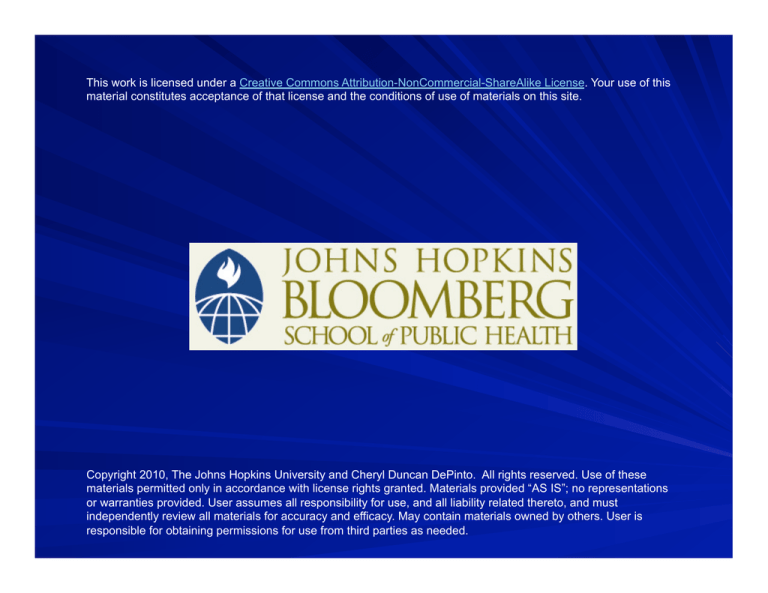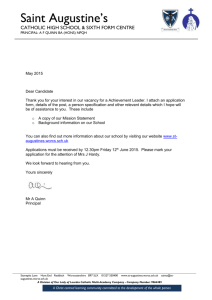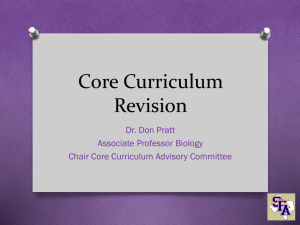
This work is licensed under a Creative Commons Attribution-NonCommercial-ShareAlike License. Your use of this
material constitutes acceptance of that license and the conditions of use of materials on this site.
Copyright 2010, The Johns Hopkins University and Cheryl Duncan DePinto. All rights reserved. Use of these
materials permitted only in accordance with license rights granted. Materials provided “AS IS”; no representations
or warranties provided. User assumes all responsibility for use, and all liability related thereto, and must
independently review all materials for accuracy and efficacy. May contain materials owned by others. User is
responsible for obtaining permissions for use from third parties as needed.
Adapted from Grunbaum, JA.. J SH (2001)SHPPS 2000 and
Allegrante, JP. J Sch H 1998: 68(5) 190-195
! Two-thirds of all deaths in U.S. can be attributed
to cardiovascular disease, cancer, and diabetes.
Preventable risk factors for these causes of
death include: tobacco use, poor eating habits,
inadequate physical activity, and overweight.
! Mental illnesses cost the U.S. about $79 billion
in 1990, with $63 billion attributed to loss of
productivity.
! The U.S. spent $2.0 trillion on health care, or
$6,697 per person in 2005. By 2015, health
care spending is projected to reach $4.0 trillion.
! Since 2000, employment-based health
insurance premiums have increased by 87%.
School districts put a valuable asset of the nation’s
schools at risk when they ignore the health of
their employees.
WHY?
BECAUSE…
! Actions and conditions that affect employee health also
influence students’ health and learning
! Protecting the physical and mental health of school
employees is integral to protecting the health of students
and ensuring their academic success.
! Health status of the community is reflected in school staff
and we know there are many issues
Blair, SN. J Sch H; 1987:57 (10) 460-473,
Allegrante, JP. J Sch H 1998: 68(5) 190-195
Blair, SN. J Sch H; 1987:57 (10) 460-473,
Allegrante, JP. J Sch H 1998: 68(5) 190-195
Blair, SN. J Sch H; 1987:57 (10) 460-473,
Allegrante, JP. J Sch H 1998: 68(5) 190-195
SCHOOL EMPLOYEE WELLNESS A Guide for Protecting the Assets of Our Nation’s Schools ww.schoolemwell.org
SCHOOL EMPLOYEE WELLNESS A Guide for Protecting the Assets of Our Nation’s Schools ww.schoolemwell.org
!
!
!
!
!
!
!
!
!
Step
Step
Step
Step
Step
Step
Step
Step
Step
1: Obtain administrative support
2: Identify resources
3: Identify a leader
4: Organize a committee
5: Gather and analyze data
6: Develop a plan
7: Implement the plan
8: Evaluate and adapt the program
9: Sustain the program
SCHOOL EMPLOYEE WELLNESS A Guide for Protecting the Assets of Our Nation’s Schools ww.schoolemwell.org
! Offer or implement health education or resources tailored to
!
!
!
!
!
!
!
employees’ needs and interests.
Develop a safe and supportive social and physical
environment.
Integrate school employee wellness into the school and/or
school district culture.
Develop linkages to programs that help employees balance
work and family (e.g., an employee assistance program).
Offer screening programs.
Offer interventions to support skills development and lifestyle
behavior change.
Help employees become better informed about when and how
to use health care services.
Evaluate and improve school employee wellness program
activities.
Eaton DK, Marx E, Bowie SE. Faculty and staff health promotion: results from the School Health Policies
and Programs Study 2006. J Sch Health. 2007; 77: 557-566.
Blair, SN. J Sch H; 1987:57 (10) 460-473





